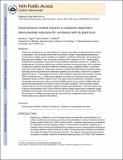Sinorhizobium meliloti requires a cobalamin-dependent ribonucleotide reductase for symbiosis with its plant host
Author(s)
Taga, Michiko E.; Walker, Graham C.
DownloadWalker_Sinorhizobium meliloti Requires.pdf (1.987Mb)
OPEN_ACCESS_POLICY
Open Access Policy
Creative Commons Attribution-Noncommercial-Share Alike
Terms of use
Metadata
Show full item recordAbstract
Vitamin B[subscript 12] (cobalamin) is a critical cofactor for animals and protists, yet its biosynthesis is limited to prokaryotes. We previously showed that the symbiotic nitrogen-fixing alphaproteobacterium Sinorhizobium meliloti requires cobalamin to establish a symbiotic relationship with its plant host, Medicago sativa (alfalfa). Here, the specific requirement for cobalamin in the S. meliloti–alfalfa symbiosis was investigated. Of the three known cobalamin-dependent enzymes in S. meliloti, the methylmalonyl CoA mutase (BhbA) does not affect symbiosis, whereas disruption of the metH gene encoding the cobalamin-dependent methionine synthase causes a significant defect in symbiosis. Expression of the cobalamin-independent methionine synthase MetE alleviates this symbiotic defect, indicating that the requirement for methionine synthesis does not reflect a need for the cobalamin-dependent enzyme. To investigate the function of the cobalamin-dependent ribonucleotide reductase (RNR) encoded by nrdJ, S. meliloti was engineered to express an Escherichia coli cobalamin-independent (class Ia) RNR instead of nrdJ. This strain is severely defective in symbiosis. Electron micrographs show that these cells can penetrate alfalfa nodules but are unable to differentiate into nitrogen-fixing bacteroids and, instead, are lysed in the plant cytoplasm. Flow cytometry analysis indicates that these bacteria are largely unable to undergo endoreduplication. These phenotypes may be due either to the inactivation of the class Ia RNR by reactive oxygen species, inadequate oxygen availability in the nodule, or both. These results show that the critical role of the cobalamin-dependent RNR for survival of S. meliloti in its plant host can account for the considerable resources that S. meliloti dedicates to cobalamin biosynthesis.
Date issued
2010-12Department
Massachusetts Institute of Technology. Department of BiologyJournal
Molecular Plant-Microbe Interactions
Publisher
Scientific Societies
Citation
Taga, Michiko E., and Graham C. Walker. “Sinorhizobium Meliloti Requires a Cobalamin-Dependent Ribonucleotide Reductase for Symbiosis With Its Plant Host.” Molecular Plant-Microbe Interactions 23.12 (2010): 1643–1654.
Version: Author's final manuscript
ISSN
0894-0282
0894-0282